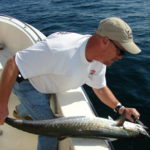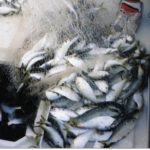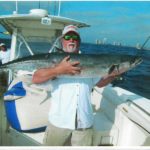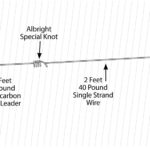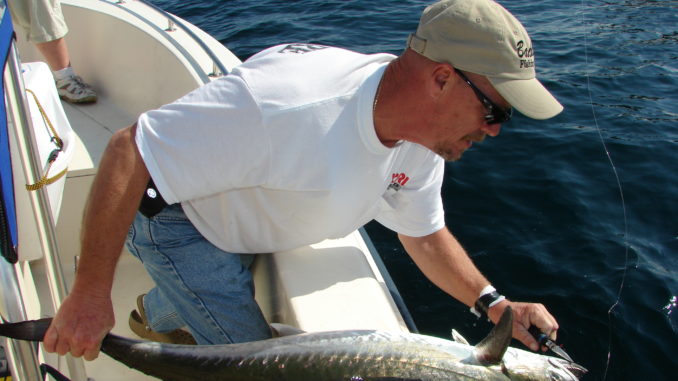
The waters off Oak Island and the mouth of the Cape Fear River teem with big king mackerel in October.
October is a special time in the ocean around the mouth of the Cape Fear River at Southport, where king mackerel gather between and try to devour every baitfish they can, arriving the last week or so of September and increasing in numbers until mid-October, when the slowly begin to move off the beach. The fishing can be epic, and there are special days every year.
Part of what makes this king run — which extends from the mouth of the river west to the South Carolina border — so special is they start at the beach and go for miles offshore. There are lots of hungry kings and a surprising number of large ones. Catching limits and releasing fish is commonplace.
Dieter Cardwell of Winston-Salem has a second home in the Southport/Oak Island area and has been a hard-core king mackerel fishermen for more than 20 years, competing in tournaments up and down the Atlantic coast and in the Gulf of Mexico with his crew mates, Mike Lundy and Kevin Alley.
Cardwell, Lundy and Alley have a special fondness for fishing off the mouth of the Cape Fear River and sometimes run there when fishing during tournaments headquartered elsewhere.
“I don’t remember exactly the first time I fished off Southport, but the fishing was excellent, and I knew I’d be coming back a lot,” Cardwell said. “The fishing is good all year, and the fall king run holds its own with anywhere. The largest kings may not be quite as large as they are at Hatteras or over in the Gulf, but there are plenty of 30- to 40-pounders, and the action is as good as anywhere I’ve seen.
“Several things make the king fishing so good off Southport. The first is the abundance of bait. I’ve fished for kings all over, from Virginia to Texas, and nowhere holds bait like around the mouth of the river. That’s good for fishermen seeking live bait, but you have to believe the abundance of bait attracts the kings, too.
“Another thing is how close the fish are,” Cardwell said. “I believe this is directly tied to the abundance of bait. Other places that don’t have as much bait rarely have as many kings, especially close in, so it has to attract them, too. There are kings beginning just beyond the surf, and they extend offshore for miles.
“One morning, a nasty storm rolled in on us while we were catching bait near the Hot Hole, so we put over several baits and began to slowly work our way to Yaupon Reef,” Cardwell said. “We couldn’t see in the heavy rain and could only move at trolling speed, so why not troll? That turned out to be a great decision as we started catching fish immediately, including our largest of the day. Even when the rain stopped, we stayed just off the beach and fished for several hours until the bite slowed. On a calm day, you can reach kings in a john boat, and there are several local fishermen that do it regularly.”
Cardwell said consistently good weather, especially during the fall, is another plus for fishing the Southport area. He said it may get rough for a day or two, but it calms back down quickly. This is the time between the heat and humidity fired thunderstorms of summer and the gales of winter.
Cardwell said a typical fishing day from Southport begins by catching bait; by October, menhaden are thick along the beaches from Cape Fear to Shallotte Inlet, anywhere from just beyond the breakers to beyond the ends of piers. Cardwell said a couple of throws of a cast net should catch all you need for fishing and fresh chum.
“I’ll recommend having a good, fast-sinking cast net for this area,” Cardwell said. “Some days, the pogeys are so thick and relaxed you can catch them with anything, but some days they are spooky, and not having a fast-sinking net leads to being frustrated. We catch most of our bait in the ocean, and sometimes they are in water more than 20 feet deep. We use Betts 22 or 22C series cast nets in 10- and 12-foot sizes.”
Cardwell said once the baitwell is full, it’s time to go fishing, and from late September into October that is usually pretty close. There are numerous places — Yaupon Reef (AR 425), McGlammery Reef (AR 420), Jim Knight Reef (AR 430), the “Old Sea Buoy,” the Sea Buoy, the WOFES and Lighthouse Rocks — close by, within sight of the beach. Yaupon Reef is often called the most-popular artificial reef in North Carolina waters; it is only 1 1/2 miles offshore. McGlammery Reef is approximately a mile offshore of Yaupon Reef, and the new Jim Knight Reef is several miles to the west.
Cardwell’s preferred trolling spread is six lines: a short surface line just behind the transom, two staggered mid-length surface lines, a long “shotgun” surface line and two downriggers with one bait approximately halfway to the bottom and the other about 10 feet above the bottom. He said when fishing in crowds, he pulls the spread closer to the boat and sometimes don’t use the shotgun line.
Cardwell and crew uses a variety of menhaden, bluefish and ribbonfish and mix them through their spread. If sharks are present early in the day, he’ll usually put up his ribbonfish baits.
“Mike and Kevin set the spread and run the lines, so I can pay attention to running the boat and watching the fishfinder,” Cardwell said. “I’m looking for bait. There may be other boats fishing the same rock or wreck, but there is rarely bait over all of it. Once we find a good pod of bait, we concentrate on fishing it. Bait along the bottom or hovering around the structure is better than no bait, but when we find bait suspended in the water column, it’s a good sign there are feeding fish around.”
King mackerel usually make hard, fast opening runs, and the first thing to do after a strike is to make sure the hooked fish doesn’t tangle any other lines. Once the lines are clear, the angler on the rod moves to the bow, and Cardwell turns toward the fish. This is especially important when fishing in a crowd and sometimes has to be done quickly.
“Many fishermen focus on the U.S. Open as being the best fishing off Southport each year, and it is good, typically the best tournament of the year, but I think the fishing gets better for the rest of October and into November,” Cardwell said. “The bite is typically along the beaches early in October, and then, around the third week, the kings begin moving offshore a little. They are still biting well; it’s just a little longer trip to get to them. The nearshore water has cooled some, and they move offshore with the bait. Finding pods of bait is the key to finding feeding kings any time, especially in the fall when the water is cooling and the kings are feeding hard to bulk up for the winter.”
Cardwell said when kings begin moving offshore, they go to places like the Shark Hole, the Horseshoe and even a little east of Frying Pan Shoals at Christmas Rock. These places are all roughly 20 to 25 miles from the mouth of the river and are easy to reach in about any ocean-worthy boat. The fall weather is usually good, so running to them isn’t a big issue. The biggest issue with the fall king fishing off Southport and Cape Fear may be having a large enough freezer to store all the steaks and fillets.
DESTINATION INFORMATION
HOW TO GET THERE — The Cape Fear River enters the Atlantic Ocean across from Southport, which is at the coastal terminus of NC 87 and NC 211. Those two highways can be accessed from most areas of North Carolina. US 74 is a key east-west highway that puts you in the right area. The town of Oak Island has free municipal boat ramps at 55th Street NE and 57th Place West. The N.C. Wildlife Resources Commission has a free ramp on Fish Factory Road off NC 133 between Southport and Oak Island. Southport Marina has a free ramp on W. West Street.
WHEN TO GO — King mackerel are in the waters off Oak Island out to Frying Pan Tower all year, but the hottest action is between the last week of September and the end of October, when kings will be caught from just off the beaches out to about 80 feet of water. The bite is usually intense in the first few miles of ocean the first week of October.
TACKLE/TECHNIQUES — Live-bait fishing is the ticket in the fall, using menhaden and bluefish, but kings will also hit mullet, spot, cigar minnows and threadfin herring, aka greenies. Dead ribbonfish, aka cutlassfish, can be fished on a long rig with several trailing treble hooks. A typical live-bait rig includes 2 feet of 40-pound single strand wire and two No. 4 Eagle Claw L774 treble hooks, with the wire joined to fluorocarbon line with an Albright special knot. Some fishermen like to add a small skirt or duster to their live-bait rigs. Try a 7-foot conventional rod with a soft tip but plenty of backbone on the butt end. Reels must hold at least 350 yards of line. Spool 20- to 25-pound mono with a 30-foot shock leader of 20- to 30-pound fluorocarbon.
FISHING INFO/GUIDES — Wildlife Bait and Tackle, 910-457-9903, www.wildlifebaitandtackle.com; Dutchman Creek Bait and Tackle, 910-457-1221, www.dutchmancreekbaitandtackle.com; Island Fishing Center, 910-201-4002, www.oakislandfishingcenter.com. See also Guides and Charters in Classifieds.
ACCOMMODATIONS — Southport-Oak Island Chamber of Commerce, 800-457-6964, www.southport-oakisland.com.
MAPS — Capt. Segull’s Nautical Charts, 888-473-4855, www.captainsegullcharts.com; Sealake Fishing guides, 800-411-9185, www.thegoodspots.com; Maps Unique, 910-458-9934, www.mapsunique.com; GMCO’s Chartbook of North Carolina, 888-420-6277, www.gmcomaps.com.

